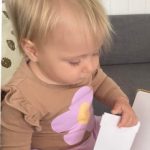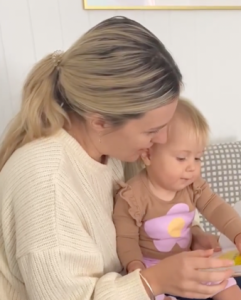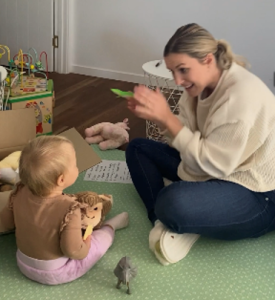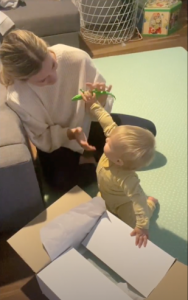14 Dear Zoo
Naomi Alberti
 The co-construction of this multimodal text is based on the child’s phase of development, children’s early reading and writing theories, key semiotic systems and multiliteracies theory. The activities draw upon the Early Years Learning Framework (EYLF, Department of Education, Employment and Workplace Relations [DEEWR], 2009). Child X is only 11 months old and as such the design aligns with key EYLF Learning Outcomes and recommendations.
The co-construction of this multimodal text is based on the child’s phase of development, children’s early reading and writing theories, key semiotic systems and multiliteracies theory. The activities draw upon the Early Years Learning Framework (EYLF, Department of Education, Employment and Workplace Relations [DEEWR], 2009). Child X is only 11 months old and as such the design aligns with key EYLF Learning Outcomes and recommendations.
This chapter demonstrates a range of teaching strategies such as modelled reading, use of music and movement, open ended play, and imaginative story telling utilising props and noises. These strategies and processes are used to assist the child in the co-construction of the multimodal ‘Dear Zoo’ literary response.
CONNECTIONS TO THE EARLY YEARS LEARNING FRAMEWORK
The activities have been designed in line with the EYLF:
Learning Outcome 5
- Children are effective communicators
- Children interact verbally and non-verbally with others for a range of purposes
- Children engage with a range of texts and gain meaning from these texts (DEEWR, 2009)
The modes of communication include music, movement, dance, storytelling, visual arts, media, drama, talking, listening, viewing, reading, writing. My activities with the child have a specific focus on the following:
-
- Music
- Movement
- Storytelling
- Drama
- Listening
- Viewing
- Reading
(DEEWR, 2009)
Our multimodal text is based on the EYLF, multimodal theories, semiotic systems and the child’s phase of development (DEEWR, 2009).
Child X is in the beginning phase of literary writing awareness and as such the activities are mostly playbased and are educator-directed learning experiences. The child is also in stage 1 of their oral development, making pre-linguistic speech-type sounds with regular babbles consonant and vowel sounds. The child can currently say ‘Mum’, ‘Dad’ and ‘uh-oh’ and regularly attempts other words and sounds but lacks clarity. As such the reading aspects of the activities must be educator-directed but allow opportunities for the child to respond with appropriate babbles and noises in response where appropriate.
There are various multimodal/semiotic systems that comprise early literacy learning, such as linguistic, visual, audio, gestural and spatial (Bull & Anstey, 2018). Each of these components has been included in the activities except for spatial.
| Activity Design | |
| The infant activities align with EYLF recommendations to ensure language and literacy development is effectively addressed | Due to child X closely approaching the toddler phase in their development some toddler focused activities are included |
| • One-to-one interactions which involve reading and telling stories, reciting rhymes, talking about experiences and things in the environment • Responding orally to their babbles and sounds (or in this case their animal sound attempts) •Inclusion of animal and postage materials and a durable story book with which they can interact and explore. • Warm and enjoyable interactions in response to their gestures, sounds and language. |
• Variety of flexible play experiences that cater for their different interests, abilities and needs. • Reading stories aloud and involving them in simple action rhymes and songs • Play experiences and text forms • Educator-directed learning experiences |
All the infant activities and literary responses are based on the fiction storybook Dear Zoo by Rod Campbell. The book is an amusing and interactive story that gives opportunities for young children to guess and at times even predict what animal is in the crate/behind the flap. The repetitive phrases help older children read along but, in this case, they were used to help Child X understand order and sequences. The book was selected because it is an easy-to-read story with large text, bright illustrations and interactive features such as the lift-the-flap animal reveal. The story explores a range of wild animals, and this seems to be a special interest for Child X as she enjoys giggling and pointing at various animals during playtimes. The book allows us to explore a range of animal noises and gestures, repetition, rhymes, object permanence (with the lift-the-flap) and using gestures for adjectives. For example, hands up high for ‘tall’ and hands reached out far for ‘wide’, ‘snap snap’ goes the crocodile, monkey goes ’oo oo ah ah’.
Activity 1: Modelled Reading (Linguistic and Visual)
Modelled reading supports a baby’s language and communication development, introducing adjectives in a fun and interactive way. This activity also connects babies to their world and in this case, to animals in their world.
 Physical contact such as cuddling and tickling has been utilised as this is an important aspect when reading to babies and we read together in a quiet and calm place (Whitehead, 2007). I endeavoured to use an expressive voice and silly animal sounds to capture Child X’s attention and interest while also pointing at key features and pictures within the book. I would allow time for Child X to respond by pointing or making sounds, and to turn the pages so that they were able to actively engage and observe the process of reading. The session was also kept brief due to the limited attention span of the child.
Physical contact such as cuddling and tickling has been utilised as this is an important aspect when reading to babies and we read together in a quiet and calm place (Whitehead, 2007). I endeavoured to use an expressive voice and silly animal sounds to capture Child X’s attention and interest while also pointing at key features and pictures within the book. I would allow time for Child X to respond by pointing or making sounds, and to turn the pages so that they were able to actively engage and observe the process of reading. The session was also kept brief due to the limited attention span of the child.
The activity has been designed in alignment with phase 1 of Reading: awareness and exploration (infancy through preschool) which should focus on children exploring their environment and build the foundations for learning to read and write (Fellowes & Oakley, 2019).
Children should:
- Enjoy listening to, viewing and discussing texts
- Understand that print carries a message
- Engage in reading and writing attempts (pretend or role-play reading)
- Identify labels and signs in their environment and label objects in books
- Participate in rhyming games
- Identify some letters and make some letter–sound matches
Activity 2: Dear Zoo Song with Action Rhymes and Gestures (Linguistic, Visual, Audio and Gestural)
Action rhymes involve children carrying out actions as they recite poems or rhymes. The actions should be performed in a way that highlights the meaning of what is being said through using repetition, rhythm and rhyme.
Action rhymes draw on young children’s motivation to play and be active, and the playfulness of the language and the actions should provide all the encouragement children need to become involved (Heald, 2004). Children can participate at some level regardless of their oral language proficiency (Overy, 2009). When reciting action rhymes with children, educators should clearly articulate the words, give emphasis to their natural rhythm and use an interesting and lively voice (Stone, 2009). The actions and words should be recited at a pace that allows children to keep up. I felt that this song was too fast-paced for the infant and a different song will be focused on in the future, such as the action song ‘The Elephant’. However, Child X seemed to enjoy dancing along to the upbeat music and the audio lyrics and animal imagery was useful in increasing their awareness of animals and their corresponding names and adjectives.
Activity 3: Literary Response Through Imaginative Storytelling using Props and Play (Visual, Linguistic and Gestural)
 This imaginative storytelling activity was based on the book Dear Zoo by Rod Campbell. The story is about Child X who wants a pet, so she writes a letter to the zoo to see if they will send her a pet. The pets chosen for the activity are based on animals that Child X has shown interest in before and during the activities. The zoo sends many different animals including a giraffe, monkey, elephant, crocodile, a hippo, a lion, and finally they get it just right with a puppy. The teacher used animal props, gestures and animal sounds to enhance the story and there is a particular focus on repetition, creating animal sounds and the concept of object permanence utilising the mail package box.
This imaginative storytelling activity was based on the book Dear Zoo by Rod Campbell. The story is about Child X who wants a pet, so she writes a letter to the zoo to see if they will send her a pet. The pets chosen for the activity are based on animals that Child X has shown interest in before and during the activities. The zoo sends many different animals including a giraffe, monkey, elephant, crocodile, a hippo, a lion, and finally they get it just right with a puppy. The teacher used animal props, gestures and animal sounds to enhance the story and there is a particular focus on repetition, creating animal sounds and the concept of object permanence utilising the mail package box.
Originally the plan for this activity was a puppet show with the child sitting on the mat, however the child would continue to crawl over to the educator or become distracted by other toys or items in the room, so we quickly adjusted this activity bringing the props down to the floor. This allowed the child to explore the props at a closer distance and to be at a closer proximity with the educator which was comforting for them. There were some missed opportunities for further gesturing in the activity, such as for stretching arms high for ‘too tall’ and stretching arms wide for ‘too big’. As such, these extra gestures were included in the next activity when creating the multimodal text. Through imaginative storytelling, children express their own imaginative stories and further, enrich children’s socio-emotional and cognitive development (Cremin et al., 2017).
Activity 4: Literary Response to ‘Dear Zoo’ Imaginative Storytelling with Animal Sounds and Gestures
 For our multimodal text we completed an imaginary storytelling with props as a response to the book Dear Zoo. This approach is also supported by empirical evidence that storytelling and story acting, a pedagogic approach pioneered by Vivian Gussin Paley (1990), affords rich opportunities to foster learning within a play-based and language-rich curriculum (Cremin et al. 2012). In addition, narrative and imaginary play is a valuable strategy for the development of spoken language and literacy within early years settings.
For our multimodal text we completed an imaginary storytelling with props as a response to the book Dear Zoo. This approach is also supported by empirical evidence that storytelling and story acting, a pedagogic approach pioneered by Vivian Gussin Paley (1990), affords rich opportunities to foster learning within a play-based and language-rich curriculum (Cremin et al. 2012). In addition, narrative and imaginary play is a valuable strategy for the development of spoken language and literacy within early years settings.
The activity encouraged Child X to attempt animal sounds and gestures when prompted. It also increased her understanding of animal names and of repeated phrases such as ‘so they sent me a…’ [open box] ‘I sent him back’ [put toy back in box].
The child’s contribution to the story was through their participation, observations, listening and through their attempts at animal noises and gestures. Observations were made throughout all five of the infant literacy activities and the multimodal text was used as further formative feedback of Child X’s language development associated with animals
Some key observations of Child X were made:
- Child X successfully gestured for ‘too tall’ and ‘snap snap’.
- Child X successfully mimicked animal sounds – ‘ah ah’ for the monkey.
- Child X brought object of interest the ‘crocodile’ to the educator for her attention and interest while the educator was speaking about the ‘crocodile’.
- Child X helped pop the ‘crocodile’ and ‘monkey’ back in the box, when the educator said ‘I sent him back’. This suggests some further development of child’s ability to listen, to follow directions and to understand order and sequence of the activity through the repetition of the activity.
Activity 5: Book Handling and Open-Ended Play with Props
Learning language and literacy through play involves babies in multisensory experiences, and this multisensory approach has been utilised within all five of the literacy activities. Specifically, this final activity focused on open-ended playtime where Child X could explore the lift-the-flap Dear Zoo book at their own leisure, along with the ‘From the Zoo’ delivery package and the various storybook animal props that were used. Open-ended play has no strict rules to follow and no ‘correct’ solutions or fixed outcomes at the end and allowed Child X to further familiarise themselves with the book and enjoy playing with the animals and practising the animal sounds and gestures.
OUTLINE OF THE CHILD’S LEARNING
The literacy activities allowed Child X to explore a range of animal noises and gestures, object permanence (with the lift-the-flap and mail package box) and using gestures for adjectives. For example, hands up high for ‘tall’ and hands reached out far for ‘wide’. The frequent use of repetition, and rhymes, helped Child X learn more about words, sounds and language formation. Hearing and using the rhyme, rhythm and repetition helps Child X further develop their early literacy skills.
The repetition of words, ideas and skills is important for early brain development, as it creates secure foundations for early learning, including the skills below (Heald, 2004):
- phonological awareness (awareness of the rhythm and rhyme)
- sounds of language and of word articulation
- syntax knowledge (structuring sentences and clauses)
- semantics (associate words and phrases with meaning)
- language fluency (practice gained through repetition)
- supporting the development of children’s ability to listen with attention, to follow directions and to understand order and sequence.
Over the five activities, the child was observed:
- exploring a range of animals through words, images, and their corresponding adjectives (through linguistic, visual, audio and gestural semiotic systems)
- using gestures for adjectives and verbs (eg. stretch arms up for ‘tall’, stretch arms out to sides for ‘wide’, clapping for ‘snap’)
- mimicking and making sounds (eg. ‘woof woof’ for the puppy or dog, ‘snap snap’ for the crocodile, ‘oo oo ah ah’ for the monkey)
- book handling (during modelled reading and open-ended play)
- practicing repetition (eg. Dear Zoo book, ‘they sent me a… ‘…so I sent him back.’)
- practicing repetition and rhyme (allows for phonological awareness, syntax knowledge, semantics and language fluency)
- developing the ability to listen with attention, to follow directions and to understand order and sequence (eg. Placing ‘the crocodile’ back in the box after ‘I sent him back’)
- experimenting with object permanence (lift-the-flap and hiding/revealing the animal props)
I believe utilising a wide variety of teaching styles and methods worked extremely well with Child X, especially being only 11 months old which means they have a very short attention span. In order to keep the activities interesting we kept the activities very hands-on and focused on an area of interest which was exploring a range of animal noises and gestures, object permanence (with the lift-the-flap and mail package box) and using gestures for adjectives. For example, hands up high for ‘tall’ and hands reached out far for ‘wide’. The frequent use of repetition, and rhymes, helped Child X learn more about words, sounds and language formation. Hearing and using the rhyme, rhythm and repetition helps Child X further develop their early literacy skills.
I was also fortunate enough to work with my own daughter for this project and having this close relationship was very beneficial as it allowed her to feel comfortable with me and we were able to dive straight into the activities. Without this bond, this may have been more difficult as it can take a while for young children to feel comfortable with new people.
Readers should avoid doing work that is very demanding or time consuming for the child, and readers should ensure that they cater the project to the interests of their child where they can. I also believe readers should make sure that their plans are not too concrete or set in stone as young children can be unpredictable in regard to how they are feeling that day, or what they are interested in so it’s important to be flexible. As an example, originally the plan for this activity was a puppet show with the child sitting on the mat, however the child would continue to crawl over to me or become distracted by other toys or items in the room, so I quickly adjusted this activity bringing the props down to the floor. This allowed the child to explore the props at a closer distance and to be at a closer proximity with me which was comforting for them. There were some missed opportunities for further gesturing in the activity, such as for stretching arms high for ‘too tall’ and stretching arms wide for ‘too big’. As such, these extra gestures were included in a later activity when creating the multimodal text.
I truly loved this experience, and it was very eye opening to me as both a parent and as a teacher about how important these formative years really are. Quite often we spend time playing, singing and dancing with our children and for most of us this just comes naturally and we forget that this ‘play time’ and ‘fun’ is actually extremely educational. Since doing the project my daughter has continued to be really interested in animals and their sounds and seeing her development, making sounds and saying new animals words such as cow, dog, and cat etc. has been amazing.
Key Takeaways
- Try to use variety of sensory experiences—opportunities to touch, feel, hear, taste and see
- Utilise open-ended playtime (examples, explore the lift-the-flap Dear Zoo book at their own leisure, along with the ‘From the Zoo’ delivery package and the various storybook animal props).
- Open-ended play has no strict rules to follow and no ‘correct’ solutions or fixed outcomes at the end and allows the child to further familiarise themselves with the book and enjoy themselves
THE CO-CONSTRUCTED MULTIMODAL TEXT
References
Anstey, M., & Bull, G. (2018). Foundations of multiliteracies: Reading, writing and talking in the 21st century. Routledge.
Bull, G., & Anstey, M. (2018). Elaborating multiliteracies through multimodal texts: Changing classroom practices and developing teacher pedagogies. Routledge.
Campbell, R. (2021). Dear Zoo (40th anniversary ed.). Pan Macmillan Australia.
Cremin, T., Flewitt, R., Mardell, B., & Swann, J. (2017). Storytelling in early childhood. Routledge.
Department of Education, Employment and Work Relations. (2009). Belonging, being and becoming: The Early Years Learning Framework. https://www.acecqa.gov.au/sites/default/files/2018-02/belonging_being_and_becoming_the_early_years_learning_framework_for_australia.pdf
Fellowes, J., & Oakley, G. (2019). Language, literacy and early childhood education. Oxford University Press.
Heald, C. (2004). The value of action songs and rhymes. Practical Pre-School, 2004(45), 1-2.
Overy, K. (2000). Dyslexia, temporal processing and music: The potential of music as an early learning aid for dyslexic children. Psychology of Music, 28(2), 218-229.
Stone, T. (2009). Songs and rhymes. Child Care, 6(5).
Taylor, S. V., & Leung, C. B. (2020). Multimodal literacy and social interaction: Young children’s literacy learning. Early Childhood Education Journal, 48(1), 1-10.
Whitehead, M. R. (2007). Developing language and literacy with young children, (3rd ed.). SAGE.

